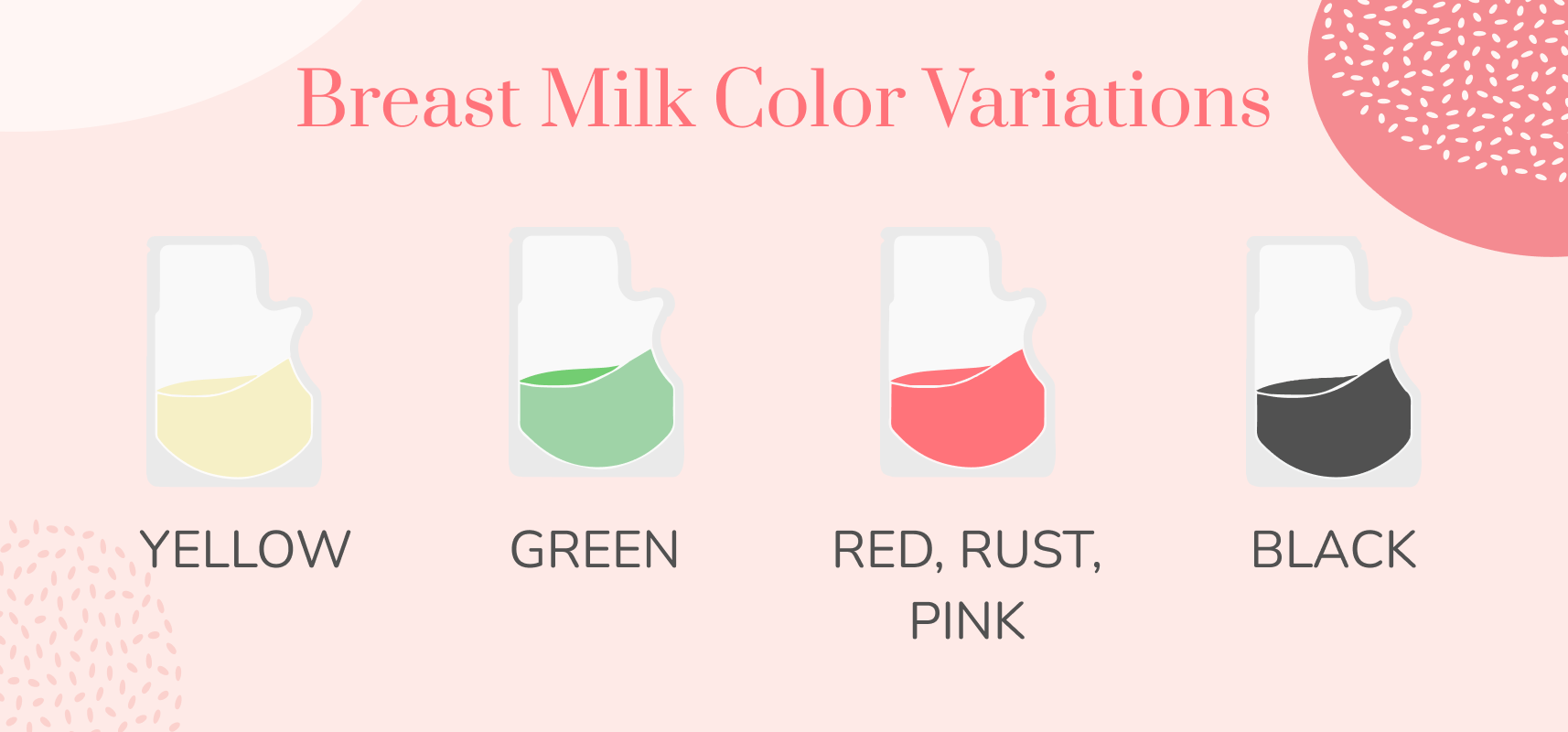Breast milk color variations are typically normal and reflect changes in your body, diet, or breastfeeding stage. From the golden yellow of colostrum to the white of mature milk, most color changes indicate healthy milk production! That said, understanding what different colors mean will help you distinguish between normal variations and situations that might require medical attention.
Understanding breast milk color changes is a big part of any mom’s breastfeeding journey. Your body produces liquid gold that adapts to meet your baby's nutritional needs, and these adaptations often manifest as color variations that can surprise new mothers during pumping sessions. Don't worry: Change is normal. Here's what you need to know about the color of breast milk and how it changes over time.
IN THIS ARTICLE:
What Does Normal Breast Milk Look Like?
Common Breast Milk Color Variations and Their Causes
What Color Is Unhealthy Breast Milk?
Why Breast Milk Differs Between Breasts
Breast Milk Changes During Illness
Expert Recommendations for Managing Color Changes
Supporting Healthy Milk Production
What Does Normal Breast Milk Look Like?
Breast milk naturally changes throughout your breastfeeding journey, and each stage has characteristic colors:
The Four Types of Breast Milk
Colostrum (First Few Days): The first milk your body produces is colostrum, often called "liquid gold" for good reason. This nutrient-dense milk appears yellow to orange due to high concentrations of beta carotene, white blood cells, and antibodies. Colostrum's rich color indicates the powerful immune protection it provides newborns.
Transitional Milk: As your milk supply increases around days 2-5 postpartum, colostrum gradually transitions to mature milk. During this period, you may notice your milk becoming more white and varies in consistency. This is because your body is adjusting its milk production to meet your baby's growing needs!
Mature Milk (After Two Weeks): Once established, mature milk typically appears white or slightly blue-tinged. Foremilk is milk present at the start of the feeding and hindmilk is the milk that is drawn out at the end. The fat content varies throughout the feeding, with foremilk appearing thinner and more translucent, while hindmilk has a creamier, thicker appearance due to higher fat content.
Hindmilk may also have the following characteristics:
-
Look more opaque white or slightly yellow
-
May have visible fat globules when expressed
-
May coat container sides more than foremilk
Understanding foremilk and hindmilk differences can help you recognize normal variations during pumping sessions.
Frozen Breast Milk: Previously frozen milk may look different from fresh milk, often appearing more yellow or having separated layers. This is completely normal and doesn't indicate a change in quality!


Common Breast Milk Color Variations and Their Causes
Yellow and Orange Milk
Yellow breast milk most commonly appears during the early breastfeeding days when producing colostrum. However, mature milk can also take on yellow or orange hues for several reasons, including:
Dietary Influences: Foods rich in beta carotene may cause yellow or orange milk. Sweet potatoes, carrots, squash, and other orange vegetables can tint your milk within hours of consumption. This is completely normal and these nutritious foods actually enhance your milk's vitamin A content, benefiting your baby's development!
Frozen Milk Storage: Previously frozen milk often appears more yellow than fresh milk due to fat separation during the freezing process. Don't stress, because this color change doesn't affect nutritional quality.
Normal Variation: Some mothers naturally produce slightly yellowish milk throughout their breastfeeding journey, which is completely normal and indicates healthy milk production!
White Milk
White milk typically indicates mature milk production has been established. If your breast milk is this color, it suggests:
-
Balanced fat and protein content
-
Established milk supply
-
Normal lactation progression
Clear and Blue Milk
Here's what to expect if your milk is light blue or clear:
Foremilk Predominance: The first milk released during feeding or pumping usually appears more translucent due to lower fat content. This foremilk is rich in lactose and provides important hydration for babies!
Lactose Overload: When breasts haven't been drained recently, accumulated milk may appear clearer. While not harmful, this can sometimes cause gassiness in babies if they receive large amounts of the lower-fat milk, so keep an eye out for fussy babies!
Normal Variation: Some mothers naturally produce milk with a blue tint. This variation is completely normal!
Green Breast Milk
Green milk is usually a result of your dietary choices and is generally not concerning. But if you do see green milk, here's what might be behind it:
Dark Green Vegetables: Leafy greens, broccoli, spinach, and other cruciferous vegetables can tint milk green. These nutrient-rich foods provide valuable vitamins and minerals that enhance milk quality, so be sure to eat plenty of them!
Supplements and Drinks: Algae supplements, certain sports drinks, or foods containing green food dyes can cause temporary green coloration. The artificial coloring passes through breast milk but don't worry—it isn't harmful to babies.
Pink and Red Milk
Pink or red breast milk can have several causes, ranging from benign to requiring medical attention. If you see pink or red milk, look for these indicators to determine the cause:
Dietary Sources: Just like your leafy greens, consuming beets, cherries, strawberries, pomegranates, and foods with red food dyes can create pink or red milk. These color changes usually appear shortly after consumption and resolve as the food is metabolized.
Cracked Nipples: Minor bleeding from cracked nipples during breastfeeding can cause pink-tinged milk. While not dangerous for babies, addressing nipple pain or soreness helps prevent infection and reduces discomfort for you.
Rusty Pipe Syndrome: This harmless condition causes brownish or rusty-colored colostrum during the first few days of breastfeeding. This may be caused by more blood flowing to the breasts after giving birth, and it usually resolves without treatment.
Mastitis: Breast infections can cause pink or red milk and are accompanied by breast pain, fever, and flu-like symptoms. You should monitor these symptoms and seek prompt medical treatment if they worsen or don't improve within 24-48 hours.
Rare Serious Conditions: Though uncommon, persistent blood in breast milk may indicate more serious conditions requiring medical evaluation. Always bring up any concerns with your healthcare provider to ensure you're feeling and healing your best!
Black Breast Milk
Black breast milk is rare and unusual, but it can happen! Here's what might be behind black breast milk:
Medication Effects: Certain medications or supplements, particularly minocycline (Minocin), can cause dark milk coloration (dark brown or black). Be sure to consult your healthcare provider about medication compatibility while breastfeeding!
Medical Conditions: Very dark milk may signal health concerns requiring immediate medical attention. Checking with your healthcare provider will help you get answers.
What Color Is Unhealthy Breast Milk?
While most color variations are normal, certain characteristics may indicate problems.
Signs of Concerning Milk Changes
Persistent Blood: The occasional pink tinge from minor nipple damage is normal, but consistent bloody milk requires medical evaluation.
Unusual Odors: Healthy breast milk smells sweet or has minimal odor. But sour, rancid, or metallic smells may indicate spoilage, infection, or a chemical reaction caused by your diet.
Sudden Dramatic Changes: While gradual color changes are normal, sudden dramatic shifts in milk color without dietary explanation warrant medical consultation.
Liz Truesdale, RN, IBCLC, and expert lactation consultant at Aeroflow Breastpumps, explains: "Most breast milk color changes are completely normal and reflect the dynamic nature of human milk production. However, persistent unusual colors accompanied by symptoms like fever, breast pain, or baby's feeding difficulties should prompt consultation with healthcare providers."
Why Breast Milk Differs Between Breasts
You may notice different milk colors from each breast. This is completely normal! Several factors may contribute to this variation, including:
Production Differences: One breast may produce more milk than the other, affecting concentration and color between the two.
Fat Content Variations: Each breast may have different fat storage and release patterns, causing color differences between sides during the same pumping session.
Timing Differences: If one breast was last emptied at a different time, the milk composition and appearance may vary significantly.
Individual Anatomy: Breast anatomy differs between sides, potentially affecting milk flow and concentration patterns.


Breast Milk Changes During Illness
When Mother Is Sick
When you're sick, it can affect your breast milk in several ways:
Color Changes: Some illnesses may cause subtle milk color changes as the body produces specific antibodies and immune factors to help you fight off infections.
Medication Effects: Safe breastfeeding medications may temporarily alter milk color without affecting safety for babies, and speaking with your healthcare provider can help you understand what to expect when breastfeeding while taking certain medicines.
Dehydration Impact: Illness-related dehydration can concentrate milk, potentially affecting color and consistency. Another great reason to keep drinking water!
When Baby Is Sick
Remarkably, breast milk composition changes when babies are ill. This is because your body responds to your baby's illness by producing an increase in white blood cells and targeted antibodies! This change can also sometimes cause subtle color changes, so don't worry if you notice a difference in color—your body is working hard to help your baby recover!
Expert Recommendations for Managing Color Changes
When to Monitor Color Changes
Normal Situations
-
After eating colorful foods
-
During different stages of lactation
-
Between morning and evening pumping sessions
-
After storing and thawing frozen milk
Situations Requiring Attention
-
Persistent unusual colors without dietary explanation
-
Colors accompanied by pain or fever
-
Baby's refusal to feed from unusually colored milk
-
Sudden dramatic color changes
Dietary Considerations
Maintaining a colorful, nutritious diet benefits both you and your baby! Maintain your nutrition by:
Embracing Color Variety: Don't avoid healthy foods that temporarily change milk color. Beta carotene-rich foods, leafy greens, and colorful fruits provide essential nutrients you need.
Track Correlations: Need help monitoring these color changes? Keep a simple log noting unusual milk colors and recent meals to identify patterns and reduce anxiety about normal variations.
Stay Hydrated: Adequate hydration helps maintain normal milk composition and appearance. Aim for at least 80 ounces of water a day.


Supporting Healthy Milk Production
Optimizing Milk Quality
Balanced Nutrition: A varied diet rich in fruits, vegetables, whole grains, and lean proteins supports optimal milk composition and normal color variations, so be sure to fill your plate with these powerful foods!
Regular Emptying: Consistent breastfeeding or pumping schedules help maintain normal milk composition and reduce extreme color variations.
Proper Storage: Following breast milk storage guidelines preserves color and nutritional quality of expressed milk. Read our guide to learn about proper storage techniques!
Working with Lactation Professionals
When in doubt, reach out to your LC! Certified lactation consultants can provide personalized guidance about:
-
Normal color variations for individual mothers
-
Identifying concerning changes
-
Optimizing milk production and quality
-
Addressing specific breastfeeding challenges
According to one of our trusted lactation consultants, Aleah Walker (IBCLC, BS, CD), "Understanding normal breast milk color variations empowers moms to feel confident about their milk production while knowing when to seek professional guidance."


When to Consult Healthcare Providers
You won't always have all the answers but don't worry—there's plenty of help available to you throughout your breastfeeding journey!
Immediate Consultation Needed
Contact healthcare providers immediately for:
-
Black or very dark milk without medication explanation
-
Persistent bloody milk with breast pain
-
Unusual colors accompanied by fever or flu-like symptoms
-
Baby's persistent refusal of unusually colored milk
Routine Consultation Appropriate
Schedule appointments for:
-
Questions about normal color variations
-
Concerns about milk production quality
-
Persistent color changes without clear dietary correlation
Color Change is a Natural Process
Breast milk color variations represent the dynamic, responsive nature of human lactation. While most changes are completely normal and reflect healthy milk production, understanding what different colors mean can empower you to make informed decisions about your breastfeeding journey! And when you do have questions, consulting with qualified lactation professionals ensures you'll receive evidence-based guidance tailored to your unique situation!
At Aeroflow Breastpumps, our team of experts are available to answer questions and guide you through pregnancy and postpartum. We're here to help! Fill out our qualify through insurance form to get started or browse our collection of classes to support your breastfeeding journey!
Remember, every mother's experience is different, and what's considered normal for one may be completely different than what's normal for you. Trust your instincts, maintain good nutrition, and seek professional support when needed to ensure the best outcomes for both you and your baby!







